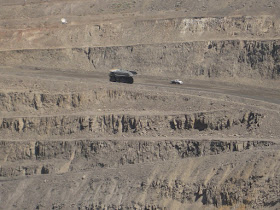
All the pictures that you see of this incredible Australian icon do not do its size and rock structure justice.
As you are drive or walk around the base the colours of the rock are constantly changing depending on where the sun is striking it.
Uluru is one of the great natural wonders of the world. This sandstone monolith stands 348 metres above ground and has a much larger mass hidden beneath the surface. Uluru is also considered by many to be the spiritual heart of Australia.
On our second day, we drove out to the rock at about 6:30a.m, and watched the sun move onto, and then up the rock. It is as if you are watching
 the rock wake up, the colour goes from brown to brilliant red in a matter of minutes and is spell binding.
the rock wake up, the colour goes from brown to brilliant red in a matter of minutes and is spell binding.We then decided to walk around the base. It is a 9.4klm walk and took us about three hours. There are times when you are walking beside the rock and other times, because of sacred aboriginal sites y
 ou are walking quite a distance away from it. There are many caves with aboriginal drawings, water holes and as it had rained recently, there was still a little bit of water running off the rock.
ou are walking quite a distance away from it. There are many caves with aboriginal drawings, water holes and as it had rained recently, there was still a little bit of water running off the rock.We enjoyed being out by the rock so we came back every day we were there to either do short walks, watch the sunset or just sit beside it. I felt like the rock was a friend and I couldn’t wait to get back out to be beside it. The drive from the camp area out to the rock is about 21 klms so you always get a good view each time you drive out there and back.
The Aboriginals ask they that you do not climb the rock as it is a sacred site and while you are in this amazing part of Australia you certainly want to respect the wishes of this incredible race of people.

I spent about an hour at the Cultural Centre watching three aboriginal ladies painting which was fascinating. I could have sat and watched them all day. One of the women has an exhibition coming up in Melbourne so she was busy finishing off a couple of her latest works.
Uluru is one of those special places that touches your heart.











